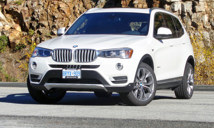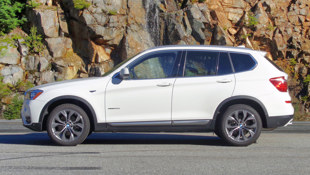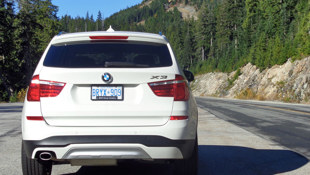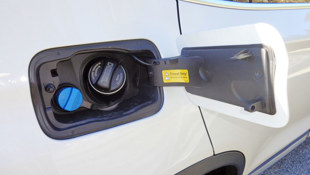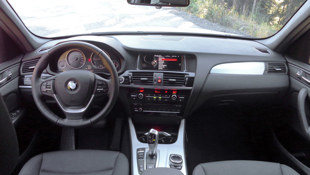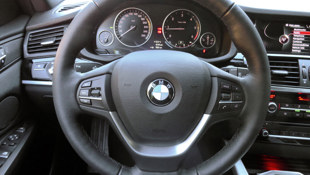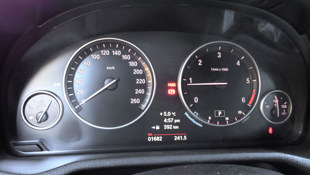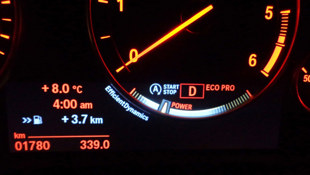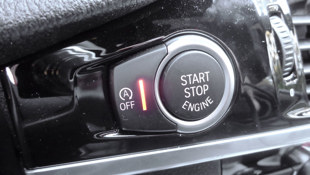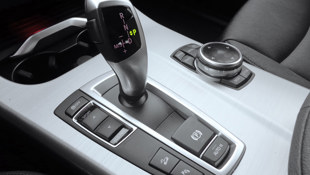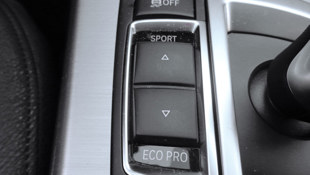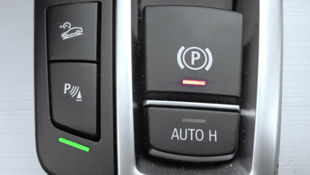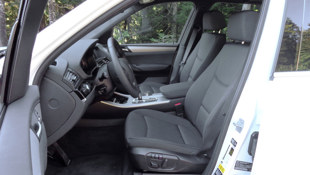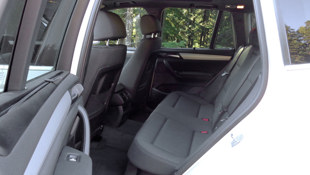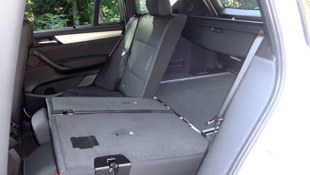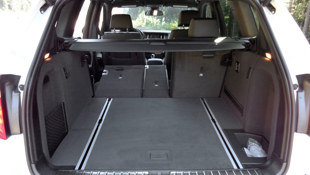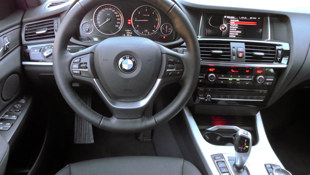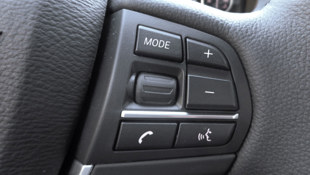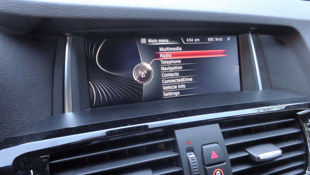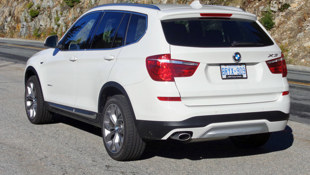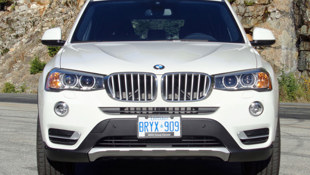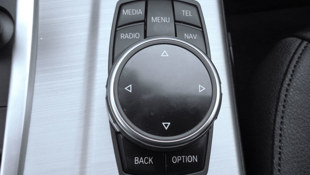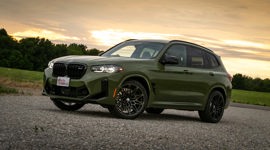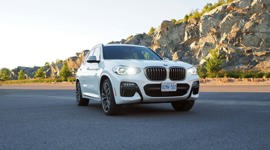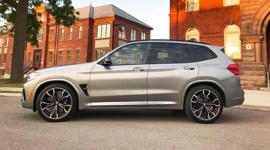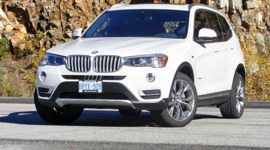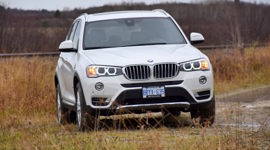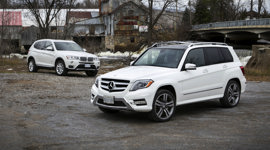 AutoTrader SCORE
AutoTrader SCORE
-
EXTERIOR STYLING7/10
-
INTERIOR8/10
-
PERFORMANCE7/10
-
COMFORT8/10
-
FUEL ECONOMY8/10
The 2015 BMW X3 28d is the latest luxury SUV/crossover to offer a diesel engine as well as a choice of gasoline engines, joining the Audi Q5 TDI and Mercedes-Benz GLK 250 Bluetec in the compact luxury SUV segment. BMW’s combination of a small 2.0L turbocharged diesel mated to a standard eight-speed automatic transmission allows it to achieve the best fuel economy in the diesel SUV category: the X3 28d delivers 8.7 L/100 km in the city and 6.9 L/100 km on the highway, or a combined 7.8 L/100 km, according to the EPA. EPA figures for the Mercedes-Benz GLK250 Bluetec are 9.8 city/7.1 hwy/8.4 combined while the Audi Q5 TDI is 9.8 city/7.6 hwy/8.7 combined. In our week-long test drive, we recorded an average fuel economy reading of 8.1 L/100 km, not far off the EPA’s combined figure of 7.8 L/100 km and NRCan’s five-cycle average of 7.9 L/100 km. Notch one up for BMW.
However, the BMW’s fuel economy comes at the price of horsepower and torque output: while the X3 28d pumps out a modest 181 hp and a decent 280 lb-ft of torque, the Merc’s 2.1L turbo diesel develops 200 hp and 369 lb-ft of torque, while the Q5 TDI’s turbocharged 3.0L V6 diesel puts them both to shame with 240 hp and 428 lb-ft of torque.
The X3’s standard eight-speed automatic “Steptronic” transmission has a lot to do with the diesel X3’s excellent performance.
But that doesn’t mean the X3 28d is a dog. It just means it has less power. And in a week of mixed city and highway driving, we had no complaints about the X3’s performance.
The reason is torque. Developing a maximum 280 lb-ft between 1,750 and 2,750 rpm, this little diesel engine with its common rail direct fuel injection, multi-stage turbocharging and variable turbine geometry, can vault the X3 from stop lights in a heartbeat and pull the X3 up steep hills with very little effort. True, the X3 28d’s (BMW supplied) 0 to 100 km/h time of 8.3 seconds isn’t awe-inspiring but it’s not slow either considering that this is a 1,919 kg five-passenger SUV with all-wheel drive. Admittedly, we didn’t try the X3 28d with a full load on board, but there seems to be plenty of extra power to compensate, particularly if the driver takes advantage of the performance-enhancing Sport mode.
Typical of modern diesels, you will notice some diesel clatter at idle, particularly if the windows are down, and under moderate to hard acceleration; but under steady-state driving and highway cruising, the diesel engine can barely be heard. And because it’s a diesel with an eight-speed automatic transmission that shifts often (and smoothly), the engine rarely has to rev above 2,000 rpm, thereby minimizing engine noise. Travelling on a level freeway at 100 km/h, the tachometer showed just 1,600 rpm in top gear.
The X3’s standard eight-speed automatic “Steptronic” transmission has a lot to do with the diesel X3’s excellent performance. It’s really a stellar cog changer, doing its job with no complaints or reservations. The driver can shift gears sequentially using the floor shifter after moving it to the M/S gate, but there are no shift paddles behind the steering wheel.
As is the way these days, performance can be enhanced electronically by pressing the Sport button near the shift lever. This causes the engine to rev higher, the transmission to shift sooner, and the steering to quicken as well as deactivating the automatic stop/start system. But given that the performance in Normal mode is very good, we didn't see the need to waste more diesel fuel in Sport Mode. Even in driver-selectable Eco Pro mode, the X3 28d accelerates and steers well while reducing fuel consumption by up to 20 percent, according to BMW. To save fuel, Eco Pro automatically selects the highest gear possible; in a gas engine, that usually saps performance, but in the X3's low-revving 2.0L diesel engine, there's plenty of torque even in higher gears.
Eco Pro mode also includes some other fuel saving measures: while coasting and braking, the X3 28d recharges the battery (as displayed in the real-time blue and red Charge/Power display at the bottom of the tachometer. The display also shows the extra kilometres gained while driving in Eco Pro mode.) And when coasting between 50 and 160 km/h, the transmission decouples from the engine, thereby saving energy.
The X3’s stop/start system, which automatically turns the engine off while you’re waiting for a traffic light to change and restarts it again when the brake pedal is released, takes less than a second to restart the engine and it is more heard than it is felt. However, we noticed that if the wipers are on when the engine stops they continue wiping but pause briefly while the engine is restarting, resuming activation after the engine starts. We also noted the engine sometimes restarts automatically while the X3 is stopped if the heater or air conditioning is on.
The X3’s Servotronic electric power steering automatically adjusts steering effort depending on the amount of steering input rather than the speed of the vehicle: small steering adjustments at high speed will result in firmer steering while u-turns at slow speeds will provide maximum steering boost and the least steering effort. Interestingly, the X3’s electric power steering system is only active when the wheel is being turned. When the steering wheel is static, say when cruising along on a straight stretch of the freeway, the electric assist is inactive. While this sounds a bit scary in theory, it seems to work in practice. I didn’t notice any delay in steering response except during the aforementioned automatic restarts.
BMW’s xDrive all-wheel drive system is standard on the X3 28d, and most of the time, you won’t even know it’s there. xDrive can vary power distribution between the front and rear axles automatically and combined with Dynamic Stability Control it enhances traction and stability when cornering on slippery road surfaces. Because the inner and outer wheels rotate at different speeds when turning, xDrive automatically applies more power to the outside wheels and brakes the inner wheels when turning, maximizing traction at all four wheels and reducing drivetrain strain. For the driver and passengers, this means that the X3 28d simply goes where it’s pointed rather than sliding or struggling. We experienced rain during our week with the X3, but no snow. In the wet, we found stability and traction to be first-rate. Interestingly, in rough terrain, the driver can view a 3D graphic of the X3’s angle and position in the centre display.
The X3 28d also includes pushbutton Downhill Assist system which allows it to creep down extremely steep hills without the driver having to brake, similar to what a Low Range gear in a traditional 4X4 can do.
Still, the X3 is more of on-road crossover than an off-road 4X4. Its wide track, beefy 19-inch tires, and independent suspension give it sure-footed handling on pavement, and it rides with a cushioned firmness typical of a BMW. Though it weighs 1,919 kg and is 1,661 mm tall, it doesn’t feel cumbersome in spirited driving but it doesn’t feel nimble either: it just feels well-planted. We liked the elevated driving position which provides a good view over the roofs of smaller cars in city traffic.
Our tester had the optional Technology Package ($1,600) which includes Active Blind Spot Detection, Lane Departure and Collision Warning, and Highbeam Assistant. Active Blind Spot Detection senses other vehicles in the left and right blind spots and issues a warning light in the side mirror if a collision is imminent; at speeds above 70 km/h, the Lane Departure Warning vibrates the steering wheel and displays a warning message if the driver drifts into another lane without signaling; at speeds above 15 km/h, the Collision Warning system detects cars ahead and warns the driver; if the brakes aren’t applied, the car brakes automatically. The system also detects pedestrians during the day at slower speeds and will automatically brake if the driver doesn’t; the Highbeam Assistant automatically turns off the high beams when approaching vehicles are detected, and turns them back on when the road is clear. For $1,600, the Technology Package is well worth it.
Though it started out as a compact SUV, the second generation X3 is just about as big as the first generation BMW X5, only not quite as tall. Cabin space in the 2015 X3 is generous, as is the luggage space: the two front and two outboard rear occupants have plenty of headroom and legroom but a centre rear passengers must straddle a tall driveline hump – the X3 is really only comfortable for four.
Cabin materials are first rate. We loved the brushed aluminum trim on the centre console, shift handle, doors and steering wheel, the subtle piano black trim around the air vents, the quality soft-touch dash plastics, and even the faux leather seats which seemed very durable, comfortable and easy to clean. Everything looks top quality.
The driver sits high in the X3 28d with good visibility in all directions, assisted by a rearview camera with driver-selectable top-down ‘surround’ view and a side view; front and rear parking sensors with audible warnings and visual warnings in the centre display, and blind spot warning chimes. Optional is a ‘Park Assistant’ that automatically parallel-parks the car once an appropriate parking spot has been found.
Both front seats are heatable and have power fore-aft, power height, and power rake - but no power lumbar adjusters. Power lumbar is available but it’s part of the $3,500 Executive Package! Even without it though, I found lower back support to be sufficient for my average frame. The X3’s driving environment includes easy-to-read round gauges, a thick-rimmed leather-wrapped heated steering wheel that tilts and telescopes manually, a wide 8.8-inch colour screen in the centre dash, a padded centre armrest with a storage bin underneath, a wide centre console with a beefy shift lever and ancillary controls close to hand - including a large iDrive dial on the right side of the centre console which controls audio, information and navigation functions on the centre screen.
The right side of the centre console might seem an odd to place to put the iDrive controller, but after lying my forearm down on the console, I found that my hand fell conveniently onto the iDrive dial. The driver or front passenger can use the iDrive controller to navigate around the large centre screen (not a touch-screen) which contains menus for different media choices, telephone, navigation, trip computer and vehicle information. The home screen offers a simple list of those topics, and by rotating, pushing, and pressing the controller, the driver can find the appropriate screen. The driver can also select major screen menus by pressing one of the buttons next to the dial, such as radio, navigation and telephone. Split screens are also available in order to see two features at once, such as the map and the trip computer. Drivers can also use hand-written letters on the surface of the iDrive controller to enter destinations for the navigation system, or use voice commands.
With BMW’s optional Connected Drive system ($500), X3 owners can also access the internet – BMW provides a one-year free subscription using a SIM card built into the vehicle with unlimited band width – a smartphone connection is not needed. This also includes BMW Online with news, weather and information services, and Advanced Real-time Traffic Information as displayed in the navigation system. It also includes a remote vehicle locator, remote door unlock, remote ventilation control from your smartphone using My BMW Remote app. You also get a complimentary three-year subscription to the BMW Response Centre which will provide info on points of interest such as restaurants, gas stations, hotels, shops or a specific address sent directly to your navigation system.
BMW’s unique floor shifter uses a one-pull, one-push motion to move from Reverse to Neutral to Drive and back again, but Park is engaged by pressing the button on the top of the shift lever. As well, the electronic parking brake and hill holder buttons are located directly behind it while the Sport and EcoPro controls, Downhill Assist, and parking sensor buttons are located just to the left of the lever within easy reach of the driver’s hand.
Behind the 40/20/40 split folding rear seatback is a roomy, fully lined cargo area of 550 L which expands to 1,600 L when the rear seatbacks are folded – that’s roomier than the cargo area in the GLK 250 Bluetec and Q5 TDI. Behind the X3’s rear seats, the trunk measures 914 mm long by 1,092 mm wide. With the seatbacks folded, the cargo length is up to 1,829 mm. The good thing about the folding centre seat is that it allows skis, poles, boards etc. to be carried at the same time as two rear passengers.
The cargo area includes a removable sliding privacy cover, an open bin for milk jugs, grocery bag hooks, an elastic mesh net for securing small items, a metal scuff guard on the loading lip, and floor rails for locking cargo in place. The rear power liftgate has gas struts which don’t obstruct the cargo opening, and the opening itself is large. If both your hands are carrying parcels, you can swing your foot under the rear bumper and the liftgate will open and close automatically, assuming you have the key in your pocket. As you can see, this is a well thought-out cargo compartment.
Our 2015 BMW X3 28d tester had a base price of $45,000 plus $8,100 worth of options and a rather hefty $2,095 freight charge for a total of $55,295 before taxes. That sounds expensive, but it’s in the same ballpark as its German competitors.
BMW X3s are assembled in Steyr, Austria.
| Model Tested | 2015 BMW X3 xDrive28d |
|---|---|
| Base Price | $45,000 |
| A/C Tax | $100 |
| Destination Fee | $2,095 |
| Price as Tested | $55,295 |
|
Optional Equipment
$8,100 (Premium Package ($6,000) Harmon Kardon sound system, satellite radio, navigation, rearview camera, panorama sunroof, parking sensors front and rear, LED fog lights, automatic trunk closer, automatic dimming side mirrors, aluminum roof rails, lights package, comfort access; Technology Package ($1,600) Active Blind Spot Detection, Lane Departure and Collision Warning, Highbeam Assistant; Connected Drive Services ($500) Internet, BMW Online, Advanced Real-time Traffic Information, Concierge Services, Remote Services; side sunshades ($350); storage compartment ($300)
|
|
